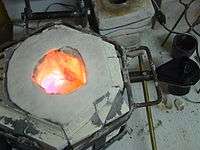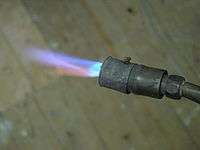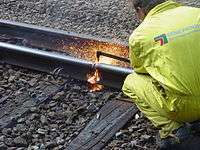Gas burner



A gas burner is a device which is used to generate a flame, in order to heat up products using a gaseous fuel such as acetylene, natural gas, or propane. Some burners have an air inlet to mix the fuel gas with air, to enable complete combustion. Acetylene is commonly used in combination with oxygen.
The gas burner has many applications such as soldering, brazing and welding, the latter using oxygen instead of air for producing a hotter flame, which is required for melting steel. For laboratory uses, a natural-gas fueled Bunsen burner is used. For melting metals with melting points of up to 1100 °C (such as copper, silver, and gold), a propane burner with a natural drag of air can be used.
Flame temperatures of common gases and fuels
| Gas / Fuels | Flame temperature |
|---|---|
| Propane in air | 1980 °C 3596 °F |
| Butane in air | 1970 °C 3578 °F |
| Wood in air (normally not reached in a wood stove) | 1980 °C 3596 °F |
| Acetylene in air | 2550 °C 4622 °F |
| Methane (natural gas) in air | 1950 °C 3542 °F |
| Hydrogen in air | 2111 °C 3831 °F |
| Propane with oxygen | 2800 °C 5072 °F |
| Acetylene in oxygen | 3100 °C + 5612 °F |
| Propane-butane mix with air | ~1970 °C 3578 °F |
| Coal in air (blast furnace) | 1900 °C 3542 °F |
| Cyanogen (C2N2) in oxygen | 4525 °C 8177 °F |
| Dicyanoacetylene (C4N2) in oxygen (highest flame temperature) | 4982 °C 9000 °F |
The above data is given with the following assumptions:
- The flame is adiabatic
- The surrounding air is at 20°C, 1 bar atm
- Complete combustion (no soot, and more blue-like flame is the key) (Stoichiometric)
- Peak Temperature
- Speed of Combustion (has no effect on temp, but more energy released per second (as adiabatic) compared to normal flame)
- Spectral bands also affect colour of flame, as of what part and elements of combustion
- Blackbody radiation (colour appearance only because of heat)
- Atmosphere - affects temperature of flame and colour due to the atmospheric colour effect
Explosive limits and ignition temperatures of common gases
| Explosive limits (lower & upper, in %) | Ignition temperatures | |
|---|---|---|
| Natural gas | 4.7 & 15 | 482-632 °C |
| Propane | 2.15 & 9.6 | 493-604 °C |
| Butane | 1.9 & 8.5 | 482-538 °C |
| Acetylene | 2.5 & 81 | 305 °C |
| Hydrogen | 4 & 75 | 500 °C |
| Ammonia | 16 & 25 | 651 °C |
| Carbon monoxide | 12.5 & 74 | 609 °C |
| Ethylene | 3.4 & 10.8 | 490 °C |
Note: Atmosphere is air at 20 degrees Celsius.
Combustion values of common gases
| Gas | Combustion value | |
|---|---|---|
| (Btu/ft³) | (MJ/m³) | |
| Natural gas (methane) | 950 to 1,150 | 35 to 43 |
| Propane-butane mix | 2,500 to 3,200 | 90 to 120 |
| Propane | 2,572 | 95.8 |
| Butane | 3,225 | 120.1 |
References
- Pocket Guide to Fire and Arson Investigation, second edition, FM Global, Table 1,2 and 3
